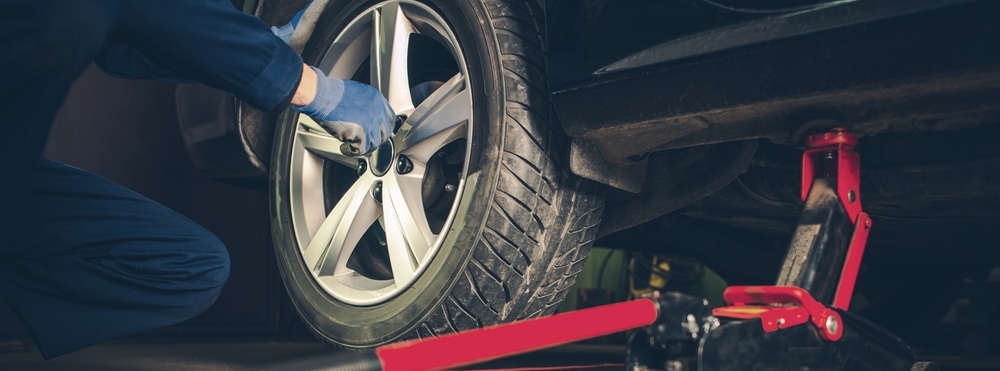
12 Mar Tire Rotation: What Is It And Is It Necessary?
 Have you ever taken your car in for an oil change, and the service person suggested a tire rotation? If you’re like me, you may have wondered if a tire rotation is really necessary or just an add-on service to charge you more money. It turns out that the service person was trying to save me money and help improve my vehicle’s performance. How, you ask? Well, following the factory-recommended tire rotation and wheel balancing intervals can actually extend tire life and improve ride comfort (among other benefits).
Have you ever taken your car in for an oil change, and the service person suggested a tire rotation? If you’re like me, you may have wondered if a tire rotation is really necessary or just an add-on service to charge you more money. It turns out that the service person was trying to save me money and help improve my vehicle’s performance. How, you ask? Well, following the factory-recommended tire rotation and wheel balancing intervals can actually extend tire life and improve ride comfort (among other benefits).
What Is Tire Rotation?
Tire rotation is simply swapping the tire position around the car to ensure the tread wears evenly. Vehicles experience accelerated wear on tires due to the extra weight of the axle, acceleration, braking, and steering. Regularly changing tire positions ensures even tread wear to help maximize the tire’s life. Tire rotation also allows you to examine each tire for damage and check for accurate air pressure.
Forward Cross Pattern
The forward cross pattern benefits front-wheel drive (FWD) vehicles. It rotates the rear tires forward on the same side and then across the car. The front tires shift to the rear but stay on the same sides. The forward cross pattern works best on front-wheel drive vehicles because it moves the tire with the least wear (the passenger rear) into the position that receives the most wear (the driver’s front). This pattern ensures that each tire eventually moves to all four positions around the vehicle, helping all the tires wear more evenly.
Rearward Cross Pattern
The rearward cross pattern benefits vehicles with rear-wheel drive (RWD) or all-wheel drive (AWD). It moves the front tires rearward and across the automobile. The rear tires move forward but stay on the same sides. This rotation pattern improves tire tread wear for rear-wheel and all-wheel vehicles because it rotates the heavier worn rear axle tires forward. This tire rotation method will evenly distribute tread wear to each tire over time.
X Pattern or Standard Cross Rotation
The X pattern (or standard cross pattern) is one of the most common tire rotation patterns because it works for any axel-driven vehicle (AWD, FWD, RWD). With this method, you move the wheels to their opposite diagonal positions. For example, you move the front left tire to the rear right position and the front right tire to the back left position. While the X-pattern is a standard pattern that works for most vehicles, there may be better tire rotation solutions for your needs. Be sure to check your owner’s manual for your vehicle manufacturer’s recommendations, but the most common method for determining which pattern is best is to pick a pattern based on the drive axle.
Tire Rotation Exceptions
- Specific vehicles and tires can’t use these typical rotation patterns because they have directional tread patterns. This means they can only be mounted to rotate in one direction. Only rotate directional tires front to back.
- Some high-performance cars may have different-sized tires for the front and rear. In this case, they can only be rotated side to side (if non-directional), never front to back.
Tire Rotation Service Intervals
To be safe, schedule a tire rotation every 5,000 to 10,000 miles or twice a year. Commercial vehicles transporting heavy loads should schedule this service every 10,000 to 13,000 miles. Don’t put off this common maintenance task because your tires are the only thing between your vehicle and the road. Well-maintained tires will help keep you safe and ensure vehicle performance.
Tire Rotation Benefits
Regular tire rotation is necessary for even tire wear. Tire rotation helps spread tread wear more evenly across all four tires, extending their lifespan and improving performance.
Extend Tire Life
There is usually a significant difference between how front tires wear and how rear tires wear. A front-wheel drive (FWD) car will wear the front tires very swiftly compared to the rear tires, while rear-wheel drive (RWD) vehicles usually wear out the rear tires more quickly. Rotating your vehicle’s tires can drastically extend the tire life of all the tires.
Improve Ride Comfort
Poor alignment or out-of-balance tires can cause uneven tread wear, which can cause vibrations, wobbles, and shaking. Uneven tire tread can also reduce traction and handling. You will get more balanced tread wear across the tire’s surface by performing routine tire rotations. Proportional tire tread on all four tires provides a quieter ride with improved comfort.
Increase Performance & Efficiency
Routinely rotated tires help support the vehicle’s suspension system. Correct air pressure, proper wheel balance and alignment, and consistent tire tread wear allow the engine to provide smooth momentum. When your vehicle is not wallowing around on its badly worn tires, you can save money at the fuel pump.
When NOT To Rotate Your Tires
It can be dangerous to rotate tires in poor condition. Since tires have a limited life span, it’s best to purchase new tires under the following conditions:
- Excessive uneven tread wear (bald spots, missing tread, patches)
- Exposed steel belting
- Obvious damage to the sidewall (blisters, cracks)
- Tire age (over 10 years)
Wheel Balancing
Tires and wheels are not perfectly uniform. The art of tire balance involves the precise weight distribution around a wheel and tire unit. Even slight variations in weight, tire construction, and manufacturing flaws can create imbalances. An imbalanced tire can cause vibrations, uneven tread wear, and handling issues. Have your tires professionally balanced by a trained auto technician. They have the specialized equipment and experience to ensure precise wheel balancing.
Static vs. Dynamic Balance
An imbalanced tire will cause wobbles and vibrations as the wheel rotates. The faster the rotation, the more pronounced the vibration. If you feel a vibrating shake in the steering wheel, that is probably an issue with the front-tire balance. A vibration felt through your seat is likely an issue with the rear-tire balance.
- Static balance handles the up-and-down motion
- Dynamic balance handles the side-to-side motion
Both types of wheel balancing are essential for a smooth ride.
Balancing Intervals
Tires must be balanced whenever they are mounted or remounted on a wheel. Rebalancing is necessary if you experience vibrations, uneven tire wear, or have had any tire repairs or changes.
Tire Maintenance in Plymouth Meeting, PA
Plymouth Auto & Tire Center will service all your tire needs, including tire rotation, wheel alignment, and wheel balancing. Our experienced technicians will diagnose your tire problems honestly and provide quality repairs.
Schedule A Tire Rotation Service
Call us at (610) 825-6558 or visit our website to schedule your tire service for improved ride comfort and extended tire life.

